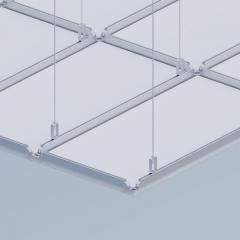
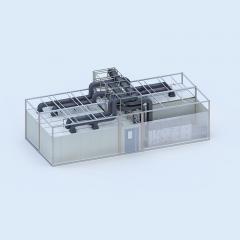
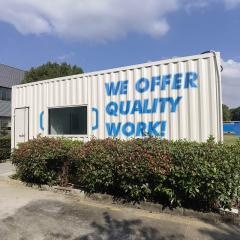
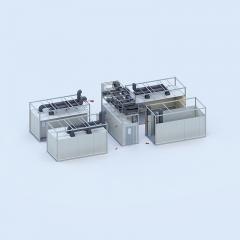
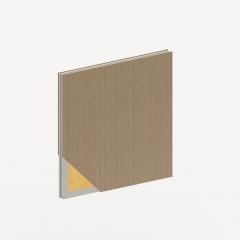
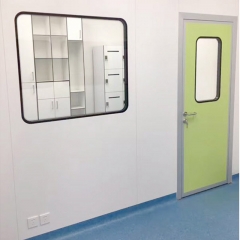
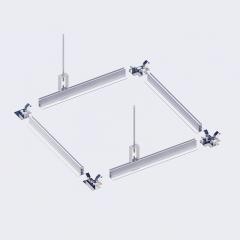
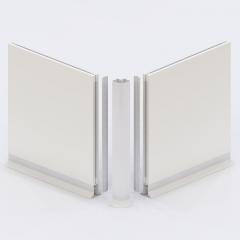
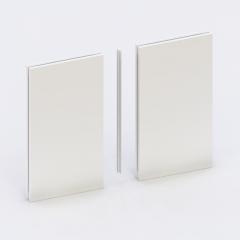
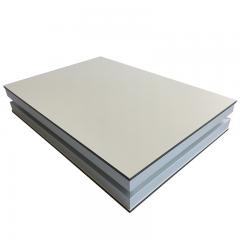
In the pursuit of optimal cleanliness and controlled environments, cleanrooms stand as sanctuaries of scientific precision. These technologically advanced spaces have revolutionized various industries, enabling the production of pharmaceuticals, electronics, and biotechnology with exceptional levels of purity. At the heart of these marvels lie the clean room partition panels, which act as sentinels, meticulously safeguarding the integrity of the environment. These partition panels, crafted with utmost finesse, employ state-of-the-art materials such as high-grade steel and specialized composites. Impeccably engineered, they ensure impeccable air circulation and minimal particle contamination, setting the stage for immaculate operations within the cleanroom's hallowed walls. Complementing the elegance of clean room partition panels is the meticulously designed cleanroom ceiling grid system, a symphony of functionality and aesthetics. This ingenious system suspends cleanroom ceilings, enhancing the unobstructed flow of air and ensuring uniform distribution of cleanliness throughout the chamber. The cleanroom ceiling grid system becomes the unseen conductor of purity, orchestrating a seamless performance within the cleanroom enclosure. Turning now to the clean room modular wall systems, we uncover a whole new dimension of versatility. These innovative creations offer the flexibility to customize the cleanroom layout, adapting swiftly to the evolving demands of research and production. By integrating modular wall systems, cleanroom designers unlock the power to reconfigure the space with ease, accentuating efficiency and adaptability. The seamless integration of cutting-edge technology with aesthetic allure, in both form and function, is a hallmark of these remarkable cleanroom installations. Let us not overlook the robust cleanroom wall systems, the silent guardians that fortify the sanctity of the cleanroom environment. Constructed with steadfast materials, these walls are endowed with excellent insulation properties, soundproofing capabilities, and fire resistance. Their purposeful design extinguishes any infiltrating external disturbances, creating a tranquil haven for scientific pursuits. In conclusion, the cleanroom industry is a realm where elegance and precision coalesce, yielding remarkable accomplishments in sectors ranging from medicine to microelectronics. As we wander through the labyrinthine corridors of modular clean rooms and container labs, we are captivated by the exquisite craftsmanship of clean room partition panels, the ethereal grace of cleanroom ceiling grid systems, the adaptability of clean room modular wall systems, and the steadfastness of cleanroom wall systems. These elements, harmoniously orchestrated, weave together a symphony of cleanliness, inspiring scientists and engineers to push the boundaries of innovation within these sacred domains.
Modular laboratories are used in a wide range of applications. Here are some common areas: Scientific research: Modular laboratories can be used to conduct various scientific experiments and research, such as biology, chemistry, physics and other fields. Researchers can freely assemble experimental modules according to their needs to quickly build different types of laboratories to support multiple research projects. Pharmaceutical R&D: Modular laboratories have important applications in the field of pharmaceutical R&D. Researchers can use modular laboratories to build drug screening platforms, cell culture laboratories, etc. to speed up the drug development process and improve experimental efficiency. New materials research: Modular laboratories provide convenience for the research of new materials. Scientists can use modular laboratories for material synthesis, testing, analysis, etc. to develop new materials with special properties. Environmental Monitoring: Modular laboratories can be used for environmental monitoring and analysis. By carrying various sensors and analytical instruments, the modular laboratory can monitor environmental parameters such as air quality, water quality, and soil pollution in real time, providing data support for environmental protection and pollution control. Education and training: Modular laboratories can also be used for scientific education and training. Schools and training institutions can use modular laboratories to provide interactive experimental teaching to help students better understand scientific principles and experimental methods. In general, the application fields of modular laboratories involve scientific research, medical research and development, new materials research, environmental monitoring, education and training and other fields. Through modular design, the laboratory can flexibly adapt to different experimental needs, improve experimental efficiency, and promote the development of science and technology. Modular LAB manufacturers、Modular laboratory manufacturers、PVT container and Box laboratory etc.
Medical Pharmaceutical and Biopharmaceutical are two different concepts, and they have obvious differences in the pharmaceutical field: Technology and production methods: Medical pharmaceuticals: Medical pharmaceuticals mainly use chemical synthesis methods to develop and produce drugs. It involves the study and synthesis of chemicals, organic compounds and natural substances to produce effective pharmaceutical ingredients. Commonly used pharmaceutical methods include chemical reactions, crystal engineering, preparation technology, etc. Biopharmaceuticals: Biopharmaceuticals use biotechnology and bioengineering methods to manufacture drugs. It mainly uses cell culture, genetic engineering and recombinant protein technology to produce pharmacologically active biomolecules, such as protein drugs, antibodies, vaccines, etc. Commonly used pharmaceutical methods in biopharmaceuticals include gene cloning, protein expression, cell culture, purification and formulation processes. Drug Types and Characteristics: Medical pharmaceuticals: Medical pharmaceuticals mainly produce chemical drugs. These drugs are usually made of synthetic chemicals, such as small molecule compounds. They have broad spectrum and can be used to treat a variety of diseases and adopt different routes of administration, such as oral drugs, injections, topical drugs, etc. Common medical pharmaceutical products include conventional drugs, antibiotics, analgesics, etc. Biopharmaceuticals: Biopharmaceuticals mainly produce biological drugs. These drugs are usually composed of biological macromolecules, such as proteins, antibodies, etc., and are synthesized in biological systems through genetic engineering technology. Biological drugs are highly specific and biologically active and can be used to target specific diseases. Common biopharmaceutical products include recombinant protein drugs, antibody drugs, vaccines, etc. R&D and regulatory requirements: Medical pharmaceuticals: The research and development process of medical pharmaceuticals is usually relatively short, and its development path and regulatory requirements are relatively mature. The development of drugs requires clinical trials at various stages to evaluate their efficacy and safety, and to obtain relevant drug registration approval. Biopharmaceuticals: The development process of biopharmaceuticals is relatively complex and time-consuming, requiring detailed bioreactor process development and optimization. Since the technologies and products involved in biopharmaceuticals are relatively complex, the regulatory requirements for their R&D and production are more stringent, and the quality, purity and safety of the products need to be ensured. Overall, there are significant differences between medical pharmaceuticals and biopharmaceuticals in terms of drug types, production technologies, and research and development processes. Medical pharmaceuticals mainly rely on chemical synthesis to produce chemical drugs, while b...
Improve efficiency: The design of the modular laboratory makes the experimental process smoother, can reduce the time and labor costs of experimental operations, and improve the efficiency of experiments. Strong flexibility: The design of the modular laboratory allows the laboratory space and equipment to be flexibly configured and expanded, and can be adjusted and optimized according to different experimental needs. High safety: The modular laboratory can realize real-time monitoring and recording of the experimental process, and can promptly discover and solve problems that arise during the experiment to ensure the safe conduct of the experiment. Environmental protection and energy saving: Modular laboratories can rationally plan space layout and improve space utilization. At the same time, environmentally friendly materials and equipment can be used to reduce the impact of the laboratory on the environment. Easy to manage: Modular laboratories can realize intelligent control and online monitoring of the laboratory environment, which can reduce the cost and errors of manual operations and improve laboratory management efficiency. In short, modular laboratories have the characteristics of high efficiency, high flexibility, high safety, environmental protection and energy saving, and easy management, which can provide better support and guarantee for scientific research work. Newly developed products:Modular Clean room、prefab clean rooms、prefab clean rooms、Portable laboratory and box laboratory etc.
Why is modular clean room a revolution in the clean room industry? Let’s look at the following. In 1913, American Henry Ford created the assembly line, which reduced the assembly time of a car from the original 12 hours to 90 minutes. At the same time, standardized production in all aspects of the assembly line also reduces the dependence of automobile quality on the level of assembly workers. The assembly line is one of the great inventions of modern society, and other industries have followed suit and promoted it. In the construction industry, prefabricated modular buildings are on the rise. On April 1, 2023, Ni Hong, Minister of the Ministry of Housing and Urban-Rural Development, said that houses should be built like cars. "Vigorously develop prefabricated buildings to enable standardized design, factory production, and assembly construction of houses. This will not only facilitate the renovation and renovation of old houses, facilitate maintenance, but also help reduce environmental pollution." On June 30, the national concrete modular high-rise building-Shenzhen Longhua Zhangkengjing project was completed and delivered. Compared with traditional construction methods, the completion and delivery period of the project was reduced from 2.5 to 3 years to 1 year, and the degree of industrial standardization increased by 80%. , solid waste emissions were reduced by 50%, and on-site labor was reduced by 50%, achieving "building a house like building a car" and becoming a national model project that combines new building industrialization and intelligent construction. In the domestic clean room industry, there are already pioneers in modular clean rooms. Up to now, modular clean rooms have been developed for many years and are deeply loved by customers. Its characteristic is that the clean room is split into various modules, standardized production in the factory, and then transported to the site for rapid construction, which reduces the dependence of traditional clean room decoration on the level of workers. The construction site has less pollution and noise, and is conducive to follow-up. relocation, expansion, upgrade and other needs. The difference between modular clean room and traditional clean room engineering: 1. Surround maintenance: frame + painted or stainless steel plate, easy to set up, dismantle and expand. 2. Top: FFU can be combined in different combinations and has its own power. It does not require a large air-conditioning system or complex equipment such as air ducts. 3. The construction period is short. Except for sealants, wires, and some screws, 98% of the materials can be reused. 4. With high appearance, it not only meets production needs, but is also suitable for visiting. 5. More suitable for cleaning needs of small areas below 300㎡.
Modular laboratory is an advanced laboratory design concept designed to improve the flexibility and efficiency of the laboratory. This approach to laboratory design divides the laboratory space into modules, each with a specific function and purpose. Through the combination and expansion of modules, different experimental needs can be met and adapted to different scientific research fields. Sendable component installation! In the design of a modular laboratory, the first thing to consider is the layout of the laboratory. The laboratory should be divided into several rooms, each with its own specific functions, such as sample processing, instrument analysis, data processing, etc. The design of these rooms should take into account their interconnection and independence to facilitate the smooth flow of the experimental process. In addition, laboratory area, equipment, ventilation, lighting and other factors are also important factors that need to be considered during design. The experimental process is an important part of the modular laboratory. The experimental process should include experimental preparation, experimental operation, experimental evaluation and other links. In the experimental preparation stage, experimental samples, reagents, instruments, etc. need to be prepared, and the instruments need to be calibrated and debugged. During the experimental operation phase, the experiment needs to be carried out according to the prescribed steps and the experimental data recorded. In the experimental evaluation stage, the experimental results need to be analyzed and evaluated, conclusions drawn and recommendations made. In a modular laboratory, each experimental module has specific functions and application scenarios. For example, the sample processing module is mainly used for the collection, preparation, storage and processing of samples; the instrument analysis module is mainly used for quantitative and qualitative analysis of samples; the data processing module is mainly used for the processing and analysis of experimental data. The connection and cooperation between these modules enable the laboratory to efficiently carry out various experimental tasks. The characteristic of modular laboratories lies in the application of intelligent control, online monitoring, automation and other technologies. The application of these technologies can improve laboratory work efficiency and quality, and reduce laboratory operating costs and risks. For example, intelligent control technology can realize automatic monitoring and adjustment of the laboratory environment to ensure the safety and stable operation of the laboratory; online monitoring technology can realize real-time monitoring and recording of experimental processes, improving the accuracy and repeatability of experiments; Automation technology can reduce the cost and error of manual operations and improve the efficiency and accuracy of experiments. As the field of scientific research continues ...
 online service
online service +8613671979988
+8613671979988 info@wonclean.com
info@wonclean.com +8613671979988
+8613671979988